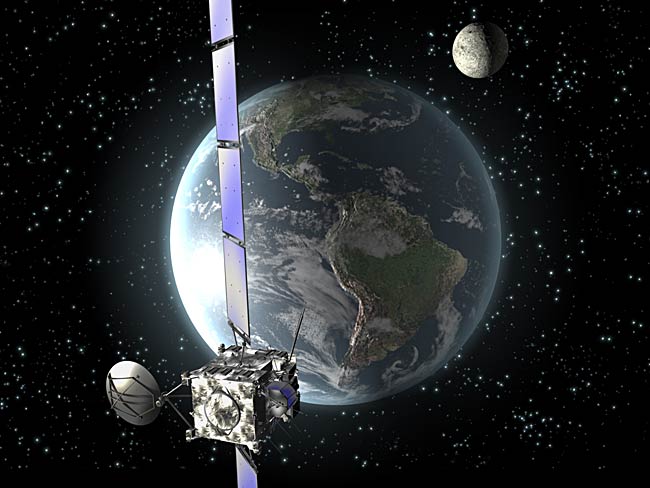Near-Miss Asteroid Found to be Artificial

The MinorPlanet Center, the world clearinghouse for information about newly discoveredasteroids, raised the alarm last week. In an email to professionalobservatories, they announced that a previously unknown asteroid would miss theEarth by just 5,600 kilometers.
The newly discovered space rock was given an official labelby the MPC, which is run by the Smithsonian Astrophysical Observatory, Massachusetts, for the International Astronomical Union. Observations for 2007 VN84 werecollected from astronomers around the world, to track the threatening celestialbody. This would be one of the closest approaches ever by a sizable asteroid – its distance away being less than half the diameter of the Earth.
Then Denis Denisenko, of Moscow's Space Research Institute(IKI), made an interesting discovery. He noticed that the incoming asteroid'strack matched that of the European space probe Rosettaon a scheduled flyby of Earth.
The Rosetta craft was launched from Europe's Guiana Space Center in early March of 2004; the purpose of the space probe is to placeitself in low orbit around the comet Churyumov-Gerasimenko at a distance of 675million kilometers from the sun. To get there, the billion-dollar craft willspend ten years boosting its velocity (using the gravityassist technique) with no fewer than three flybys of Earth and one of Mars.
Get the Space.com Newsletter
Breaking space news, the latest updates on rocket launches, skywatching events and more!
Denisenko's discovery came none too soon; Britain's Royal Astronomical Society was preparing a bulletin for the media that would havebeen released on Monday.
In an editorial notice, the MPC stated:
The minor planet 2007 VN84 does not exist and thedesignation is to be retired.
Thisincident, along with previous NEOCP postings of the WMAP spacecraft, highlightsthe deplorable state of availability of positional information on distantartificial objects (whether in earth orbit or in solar orbit). The DistantArtificial Satellites Observations (DASO) page lists a number of such objects,but has to be updated on a fairly regular basis from five different sources anddata is not always available for the timespans needed. A single source for informationon all distant artificial objects would be very desirable.
This real-life story reminded me of a fictional one. In hisaward-winning novel Rendezvouswith Rama, SF writer ArthurC. Clarke wrote about the approach of a mysterious asteroid, designatedRama:
At a rather horrifying cost, a space-probe soon to belaunched from Mars ... could be modified and sent on a high-speed trajectory tomeet Rama. Rama ... would be in real close-up for less than a second ...
Thefirst images, from ten thousand kilometers away, brought to a halt theactivities of all mankind. On a billion television screens, there appeared atiny, featureless cylinder ...
In other asteroid news:
- FirstAsteroid Belt Found Around Star Like Our Sun
- MITTether For Walking On Asteroids
- AsteroidNamed After Douglas Adams
Via 'Deadly asteroid' is a space probe; take a look at the MinorPlanet Electronic Circular that cleared things up.
(This Science Fiction in the News story used withpermission of Technovelgy.com – wherescience meets fiction)
- SPACE.com Video Player: The Asteroid Paradox
- SPACE.com Video Player: Take One Asteroid – A Recipe for Space Civilization
- All About Asteroids
Join our Space Forums to keep talking space on the latest missions, night sky and more! And if you have a news tip, correction or comment, let us know at: community@space.com.
Bill Christensen is the founder and editor of Technovelgy, a website dedicated to cataloguing the inventions, technology and ideas of science fiction writers. Bill is a dedicated reader of science fiction with a passion about science and the history of ideas. For 10 years, he worked as writer creating technical documentation for large companies such as Ford, Unisys and Northern Telecom and currently works to found and maintain large websites. You can see Bill's latest project on Twitter.









